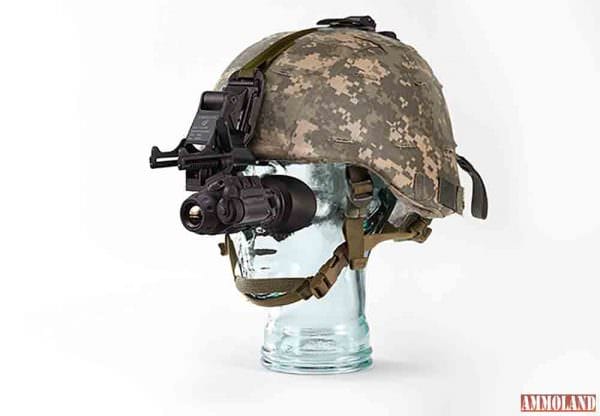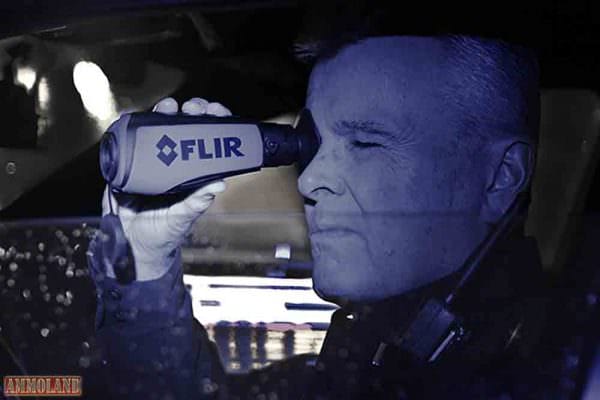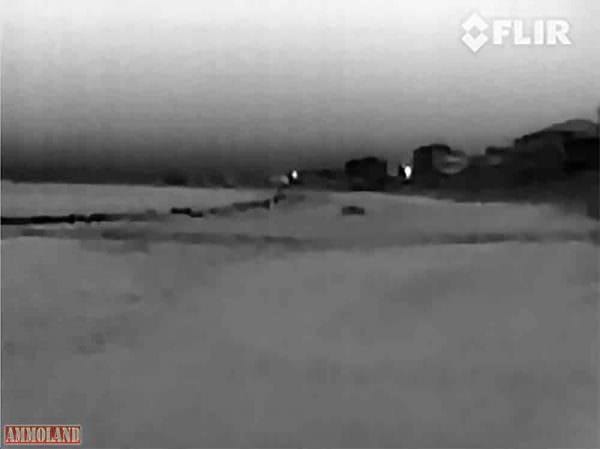

WILSONVILLE, Ore. –-(Ammoland.com)- It’s safe to say that every cop knows about thermal-imaging devices, more commonly known as Forward Looking Infrared (FLIR). It’s a magical technology that lets them see through darkness, fog, dust and even works in the daytime. Rank-and-file officers know that having a FLIR device available would dramatically change the way they work, making their job both easier and safer.
Many in law enforcement think they’ll never have FLIR in their squad car; they believe the technology is too costly to be sitting on the passenger seat next to the binoculars, clipboard and that DVD his wife wanted him to drop off. The SWAT guys and the helicopter units may have access to thermal imaging, but that guy or gal cruising slowly down the street at 4 a.m. looking for trouble will probably never be so lucky.
That is, until now. Real street cops who make real street-cop salaries now have the ability to put FLIR with their gear and develop an entirely new sixth sense with which to monitor their beats and increase their situational awareness.

FLIR has been around since the 1960’s as classified military technology. Initially bulky, incredibly expensive and power-intensive, it eventually became more efficient, smaller, lighter, de-classified and today, much more affordable.
In fact, the least-expensive FLIR devices now rival the cost of the cheapest night vision devices (NVD). However, the difference in the two technologies is literally night and day.
NVD’s work by amplifying existing light and displaying the resulting image on a small screen. They work reasonably well, but NVD’s have several serious drawbacks: they don’t work from dawn to dusk or anywhere there is bright light, they can’t see through fog, smoke or dust and most significantly, if the target is motionless or camouflaged, an NVD simply becomes a pricey spotting scope.

Thermal imaging is significantly different. It has none of the drawbacks of NVD’s with the added benefit of painting a glowing picture of hidden suspects. This is a dealmaker and lifesaver when facing the choice between thermal imaging and NVD’s.
Consider searching a huge, dark, windowless warehouse after a break-in. After securing the perimeter, an officer and backup have a couple of choices: turn on the lights (if they can find and operate the electrical panel), walk around waving their flashlights (giving away their positions and potentially drawing fire), or wait for somebody to arrive who has been issued an NVD (if such a person is even available).
After the interminable wait for an NVD, the officer learns that the goggles weren’t worth the trouble; he or she can only see as far as the weak integral illuminator can reach in the total darkness. Ironically, their flashlights are too bright and make the goggles equally useless.
Now, consider the same scenario if one of the officers had possessed a personally owned thermal-imaging device: After slipping through the door, he or she is instantly alerted to two glowing apparitions burrowed in among the pipes at the far end of the pitch-black building. Their friendly district K9, Officer Jaws, gets to say Hello.
FLIR is useful in countless similar situations. In the city, one can look down a dark alley and instantly see all the warm-blooded creatures – good and otherwise – glowing and clearly highlighted in any number of user-selectable color palettes. For officers working in rural districts, people fleeing into woodlands or agricultural fields might as well be wearing a neon sign around their neck.
Are you sold yet? Of course, but there is still that little matter of cost since the daughter needs braces, the transmission in your wife’s car is making that funny noise again and you haven’t even sprung the idea about that new fishing boat. A thermal device is out of the question, right?

Actually, there are cost-effective thermal-imaging solutions that don’t require a cop to win the lottery. Some of the most popular and affordable devices on the market are the Scout Series of thermal imagers manufactured by industry leader, FLIR Systems, Inc. With a street price below $600, the Scout TK Pocket-Sized Thermal Vision Monocular is less expensive than many NVDs, while offering the expanded benefits and applications of thermal. They’re durable, too, so forget your worries about damage from fumbles or spills.
With the less-expensive units, you can’t expect the same imaging quality as a helicopter-borne FLIR unit. But for the price, the Scout TK offers enough resolution to detect man-sized objects at over 100 yards, depending on local conditions. Such units make it easy to determine if that indistinct lump slouching next to a dumpster is a bad guy or a trash bag.
Moving up the cost scale gets you higher resolution, which allows target identification at a longer range. FLIR’s popular LS-XR handheld thermal monoculars are designed for law enforcement, and offer resolutions up to 640×480 that can ID a human-sized target at over 1,200 yards, or a small vehicle from over 2 miles away. With street prices between $2,600 and $6,400 per unit, the cost might prove challenging for an individual officer, but is certainly within the purchasing power of even the smallest department or unit. As with any gear or gadget, it pays to shop around, as actual prices can vary significantly from one retailer to another.
FLIR also offers versatile options like the all-new Q14; it’s the lightest and smallest full-featured FLIR thermal monocular available. Featuring FLIR’s new compact, uncooled Boson core, a thermal resolution of 640×480, and a fixed 19mm lens, the versatile new handheld FLIR Q14 also offers multiple mounting options for helmets, goggles, and weapons. These highly adaptpable, high-performance thermal-imaging units are expected to be available within the next few months and retail for under $2,000.
Not only can FLIR save an officer’s life, it can also save his or her job or reputation. All FLIR Scout Series, LS-XR and Q14 Thermal Vision Monoculars feature the ability to capture still images and video. IA or the DA, compelling video evidence is just an upload away.
Thermal imaging is one of those technologies that will eventually become a part of every cop’s life. Fortunately, we’ve reached the point where motivated front-line officers don’t have to wait for access to one of these life-saving devices. That’s great news for the good guys and gals on the thin blue line… and a nightmare for the two-legged predators who used to rule the night.
About FLIR Systems
FLIR Systems, Inc. is a world leader in the design, manufacture, and marketing of sensor systems that enhance perception and awareness. FLIR’s advanced systems and components are used for a wide variety of thermal imaging, situational awareness, and security applications, including airborne and ground-based surveillance, condition monitoring, navigation, recreation, research and development, manufacturing process control, search and rescue, drug interdiction, transportation safety, border and maritime patrol, environmental monitoring, and chemical, biological, radiological, nuclear, and explosives (CBRNE) threat detection. For more information, visit FLIR’s web site at www.FLIR.com,
